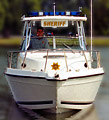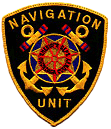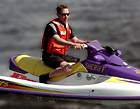 |
 |
 |
 |
 |
|
Deputies reassigned to this team during boating season are responsible for enforcing all New York State Navigation Laws, and patrolling and enforcing boating laws on all navigable waterways within and bordering Onondaga County. Some of their duties include law enforcement, accident investigation, search and rescue operations, commercial vessel inspections, marine inspections, and providing boater safety education.
WATER RULES & REGULATIONS
Age requirements to operate a motorboat:
You can operate a motorboat (excluding Personal Watercraft) if you are:
- Under 10 years old and have a person 18 or older on board with you
- Between 10 and 18 years old and have a person 18 or older on board, or if you hold a Safety Certificate
- 18 years old or older
Bow Riding:
Bow riding is prohibited unless the vessel has an open bow designed specifically for passengers.
Personal Watercraft (Jet Ski):
Most laws that apply to boats also apply to Personal Watercraft (PWC). There are additional restrictions placed specifically on PWC:
- As of 1/1/04, anyone operating a Personal Watercraft, or Jet Ski, must complete a Boating Safety Course.
- Operation of a PWC is prohibited from sunset to sunrise.
- The operator of a PWC and all passengers must wear a Personal Flotation Device (Life Jacket). A Type III PFD is recommended.
- If equipped, the engine cut-off lanyard must be attached to the operator.
- Visual distress signals and a sound-signaling device (horn or whistle) must be carried.
- The operation of a PWC is not allowed within 500 feet of a marked swim area.
- Reckless operation, such as wake jumping, playing “chicken” and weaving in and out of congested traffic, is prohibited and constitutes a misdemeanor.
Vessel Required Equipment:
The equipment required on board a vessel is:
- Anchor:
- All mechanically propelled vessels must carr an anchor and line of sufficient weight and strength to provide the vessel with safe anchorage.
- The anchor line should be between four and seven times the depth of the water in which you would normally anchor.
- Anchor Lights:
- At night, all vessels between 7 and 50 meters in length must exhibit an all around white light, when at anchor. By day, a black ball shape shall be exhibited.
- Bell:
- All vessels 39 feet and greater in length are required to have a bell. The purpose of a bell is to comply with the rules when anchored or grounded in reduced visibility.
- Fire Extinguishers (for mechanically propelled vessels):
- Outboards less than 26 feet and of open construction are exempt.
- All others less than 26 feet – one (1) United States Coast Guard (USCG) Approved Type B-1 Extinguisher
- From 26 feet up to 40 feet – two (2) USCG Approved Type B-1 Extinguishers
- From 40 feet up to 65 feet – three (3) USCG Approved Type B-1 Extinguishers
- On any vessel – a Type B-II Extinguisher may be substituted for two Type B-1 Extinguishers
- Vessels equipped with approved fixed extinguishing systems may carry one less B-1 Extinguisher.
- Navigation Lights:
- Vessels must display their navigation lights at all times between sunset and sunrise, and during daylight periods of reduced visibility.
- Sail vessels less than 23 feet and manually propelled vessels may carry a lantern with a white light that can be displayed in time to prevent a collision, in lieu of fixed lighting.
- Law enforcement vessels may carry a blue flashing light. No other vessels are permitted to carry a blue light. If you see this light, reduce speed, yield, and, if necessary, stop your vessel.
- Personal Flotation Devices (Life Jackets):
- Personal Flotation Devices (PFD) are mandatory equipment on board a vessel.
- Every pleasure vessel operated in New York State must carry at least one United States Coast Guard (USCG) approved Type I, II, or III Personal Flotation Device (PFD) for each person on board
- All Personal Flotation Devices on board your vessel must be:
- serviceable: free of rot, tears, punctures, water logging, and all straps functional
- readily accessible: within reach in the event of an emergency, never kept in plastic bags or under lock and key
- appropriate size for the intended wearer: check the USCG approval label for information on the intended user for a particular PFD
- A Type I, II, or III Personal Flotation Device must be worn by:
- Children under the age of twelve on board any vessel, unless they are in a fully enclosed cabin.
- Anyone being towed behind another vessel, such as water-skiers, tubers, parasailers, etc. (This does not apply when you are on a disabled vessel being towed.)
- Anyone operating or riding on a Personal Watercraft (Jet Ski, Wave Runner, or similar craft)
- Visual Distress Signals:
- State law requires all mechanically propelled vessels 16 feet in length or greater to carry visual distress signals as required by the United States Coast Guard. It is recommended that all vessels 16 feet or greater in length carry at least three USCG Approved hand-held day/night flares at all times.
- All flares or other pyrotechnic devices, must be USCG Approved
- Flares generally have a three-year service life and must not be past their expiration date.
- Never use road flares on your boat; they produce hot slag, which can cause a fire.
- Powerboats less than 16 feet and sailboats less than 26 feet only need to carry visual distress signals when operating at night.
- Boaters must carry a fluorescent flag for daytime use unless their vessel is equipped with other sufficient daytime signals, such as day/night flares.
- Whistle or Horn:
- Mechanically propelled vessels less than 39 feet in length must, at a minimum, have a mouth whistle that is capable of producing a blast of two or more seconds in duration, which can be heard for at least one-half mile.
- Mechanically propelled vessels of 39 feet in length or greater must carry a mechanical whistle or horn capable of producing a blast of two or more seconds in duration, which can be heard for at least one-half mile.
- Other Recommended Equipment:
- Tool kit, First Aid kit, oar/paddle, radio, spare lines, binocular
Vessel Speed:
Throughout New York State, vessel speed is generally limited to 5 mph when you are within 100 feet of the shore, dock, pier, raft, float, or anchored boat. On some specific bodies of water the 5 mph limit has been extended to 200 feet, and there may be a 45 mph daytime and 25 mph night time speed limit.
Local ordinances also may further regulate the speed of boats operated within specific areas.
- In the absence of a posted speed limit, vessels must be operated in a manner that will not endanger others.
- A vessel must be able to stop safely within the clear space ahead.
- A vessel operator is always responsible for any damage caused by the vessel’s wake.
- Prudent judgment requires operators to reduce speed when passing marinas, fishing vessels, workboats, or other similar areas.


You must be logged in to post a comment.